- Home
- Orhan Pamuk
The Black Book Page 46
The Black Book Read online
Page 46
“I won’t give my home address,” he said. “But we could meet somewhere else. Nine o’clock tonight, say, in front of Aladdin’s store.”
Even this bit pleased the husband and wife so much that Galip was made uncomfortable by the gratitude on the other end of the line. Would Jelal Bey prefer that they bring an almond cake or else petit fours from the Lifespan Cake Shop? Seeing how they’d be sitting down for a long chat, how about nuts and stuff and a large bottle of cognac?
When the weary husband cried, “I’ll bring along my photograph collection, the mug shots, and the pictures of the high-school girls too!” and gave a frightening laugh, Galip realized an open bottle of cognac must have been sitting between the husband and wife for quite a while. They repeated the time and the place of the meeting enthusiastically and hung up.
Chapter Thirty-three
MYSTERIOUS PAINTINGS
I appropriated the mystery from the Mathnawi.
—ŞEYH GALIP
The grandest of all dens of iniquity, not only in Istanbul and all of Turkey but in all the Balkans and the Middle East, was opened in the summer of 1952, on the first Saturday in June to be exact, on one of the narrow streets off the red-light district in Beyoğlu which go up to the British Consulate. The happy occasion fell on the same date as the outcome of a hotly contested painting competition that had lasted six months. The famous Beyoğlu mobster who owned the place, a fellow who would eventually become legendary by virtue of having disappeared into the waters of the Bosphorus in his Cadillac, had set his heart on getting scenes of Istanbul painted on the walls of his establishment’s spacious lobby.
The mobster hadn’t commissioned these paintings in order to become a patron of this art form, which remained terribly undeveloped in our culture thanks to the prohibition against it in Islam (I mean painting, not prostitution), but for the purpose of supplying his distinguished clients, who came to his pleasure palace from all sectors in the city and the country, with the enchantments of Istanbul along with music, drugs, alcohol, and girls. When our mobster was turned down by academic painters who would only accept commissions for bank buildings (armed as these painters are with protractors and triangles in order to represent our village damsels in the shape of rhomboids in imitation of Western cubist art), he’d called for the artisans, sign painters, and craftsmen who ornament the ceilings of provincial mansions, the walls of outdoor movie theaters, and gussy up vans, carts, and snake-swallower’s tents at local fairs. And when the only two artisans to come forth after many months both claimed, as do real artists, to be the better craftsman, our racketeer, taking his cue from bank presidents, put up a large sum of prize money and set up a contest between the competing artisans for the “Best Painting of Istanbul,” offering the two ambitious contestants opposite walls in the lobby of his pleasure palace.
Right off, the two artists, being suspicious of each other, had put up a thick curtain between them. One hundred and eighty days later, on the night the pleasure palace was inaugurated, the same patched curtain was still in place in the lobby, now full of gilt chairs upholstered in crimson waled velvet, Holbein rugs, silver candelabras, crystal vases, portraits of Atatürk, porcelain plates, and stands inlaid with mother-of-pearl. When the boss pulled the sackcloth curtain aside for the distinguished crowd among whom even the governor was present in his official capacity (after all, the joint was formally registered as the Preservation of Classical Turkish Arts Club), the guests beheld a splendid view of Istanbul on one wall and on the wall directly opposite it a mirror that made the painting, in the light of the silver candelabras, appear even finer, more brilliant, and more attractive than the original.
Naturally, the prize went to the artist who’d installed the mirror. Yet for years afterward many of the customers who found themselves in the clutches of the vice joint were so bewitched by the incredible images on the walls that, experiencing various delights in either masterpiece, they’d walk up and down between the two walls, viewing both works for hours on end, trying to figure out the mystery of the pleasure they felt.
The scrawny, miserable mongrel eyeing the lunch stand in a market scene on the first wall was transformed into a sad but cunning beast when you looked at the reflection in the mirror opposite, yet when you went back to the painting on the first wall, you perceived not only the dog’s cunningness, which must have been there all along in the original, but also a suggestion of movement that aroused your further suspicions; crossing the room once more for a confirming glance in the mirror, you saw strange stirrings that might explain the nature of that movement, and now, completely bewildered, you found it difficult to hold yourself back from running over to look again at the original painting on the first wall.
A nervous old customer had once detected that the dry fountain in the painting, located on the square that hooked up with the street patrolled by the sad dog, ran like crazy in the mirror. When he went back to the painting again, flustered like an absentminded dotard who suddenly remembers that he’s left the water tap on back home, he realized that the fountain was in fact dry; yet, when he witnessed water gush even more abundantly in the mirror this time, he sought to share his revelation with the women who worked there, but meeting with indifference on their part, for they were sick and tired of hearing about the mirror’s tricks, he pulled back into his solitary life, the essence of which is, and has always been, not being understood.
Yet in fact the women who worked for the joint were not indifferent; on snowy winter nights when they lolled around telling each other the same old fairy tales, they made use of the painting’s tricks, and those of the mirror opposite it, as an amusing touchstone to gauge the personalities of their clients. There were the hasty, insensitive, anxious ones who did not notice in the slightest the mysterious discrepancies between the painting and its reflection. These were men who either kept going on and on about their own problems or else expected to get pronto the only thing men want from bordello girls whom they can’t even tell apart. There were others who were totally wise to the play between the mirror and the painting but didn’t make anything of it; these were men who’d already been through too much to be perturbed by anything, fearless men who were to be feared. Then there were others who bedeviled the B-girls, the waiters, and the gangsters with their apprehensions, and who, as if they were suffering from some obsession with symmetry, childishly demanded that the discrepancy between the painting and the mirror be corrected as soon as possible. These were tightfisted, penurious individuals who could never let go of the world either drinking or making love; being stuck on bringing order into everything made them poor lovers and miserable friends.
Some time later, when the inmates of the pleasure palace had become inured to the dalliance of the mirror with the painting, the police chief, who frequently honored the joint with the kindness of his protective wings rather than the powers of his purse, came face-to-face in the mirror with a shady looking baldheaded fellow who was depicted toting a gun in a dark alley; that’s when he had a hunch that this was the very perpetrator of the infamous “Şişli Square Murder” and, asserting that the artist who’d installed the mirror on the wall knew the mystery surrounding the murder, he’d launched an investigation into the artist’s identity.
On another occasion, one sticky humid night in summer when the filthy water running down the sidewalks couldn’t make it to the grate on the street corner before turning into steam, the son of a land baron, who’d left his father’s Mercedes parked in front of a NO PARKING sign, seeing in the mirror the image of a good homemaker who wove rugs in her home in the slums, had concluded that she was the love of his life he’d been looking for; yet when he turned to the painting, he was only confronted by one of those sad colorless girls who inhabit his father’s villages.
As far as the boss was concerned—himself slated to discover the other world within this one by driving his Cadillac into the waters of the Bosphorus as if it were his stallion—all the pleasant jokes, the pleasant coincidences
, and the world’s mystery were tricks perpetrated neither by the painting nor the mirror; customers high on drugs and booze, flying on clouds of woe and melancholy, rediscovered the golden age in their imaginations and, full of the joy of solving the mystery of that lost world, they confused the enigmas in their minds with the replica before their eyes. Despite his hardnosed realism, the famous gangster had been observed on Sunday mornings cheerfully joining in a game of “find the seven differences between the two pictures” with the children of the B-girls, the girls and boys waiting for their weary mothers to take them to the kids’ matinee in Beyoğlu.
But the differences, the significances, and the mind-boggling transformations on the two walls were not merely seven, but endless. The representation of Istanbul on the first wall, although its technique was reminiscent of scenes painted on horse carts and on tents at local fairs, fetched up, in the mirror’s treatment of its subject matter, unnerving associations with dark and creepy engravings. The mirror opposite showed the large bird floating in one corner of the fresco on the opposite wall as if it were beating its wings languorously like a mythic creature; the unpainted façades of ancient wood-frame mansions in the fresco were transformed in the mirror into terrifying faces; fairgrounds and merry-go-rounds became livelier and more colorful in the mirror; old-fashioned streetcars, horse carts, minarets, bridges, murderers, pudding shops, parks, seaside cafés, Municipal Lines ferryboats, inscriptions, trunks were all transformed into signs of a realm that was altogether different. A black book the artist had prankishly stuck into the hand of a blind beggar turned into a two-part book in the mirror, a book with two meanings and two stories; yet, looking at the painting, one realized the book was of uniform consistency and that its mystery was lost in itself. Our domestic movie star with the red lips, bedroom eyes, and long lashes, whom the artist had depicted on the wall in the manner of fairground art, was transformed in the mirror into the poverty-stricken, big-breasted national mother figure; then, casting another clouded glance back to the first wall, you recognized with horror and pleasure that the mother figure wasn’t who she appeared to be but your wedded wife you’d been sleeping with all these years.
But what was most deeply disturbing at the pleasure palace were the new significances, the strange signs, the unknown worlds that appeared in the faces reflected in the mirror, the ones that belonged to the interminable multitudes on the bridges and in the streets, faces that appeared everywhere in the artist’s creation. Looking first at the painting and then at the mirror, the befuddled customer could perceive that someone’s visage (someone who appeared to be just an ordinary fellow or a happy-go-lucky guy wearing a melon hat) when reflected in the mirror was crawling with signs, with letters, that became transformed into a map or the traces of a missing story, giving certain viewers, who were now also contained in the mirror as they paced up and down among the velvet chairs, the impression that they were privy to a secret known only to an elite few. Everyone knew that such persons, whom the bordello girls treated like pashas, would not rest until they discovered the secret involving the painting and the mirror, and would be ready to set forth on all sorts of journeys, adventures, and free-for-alls for the sake of finding the solution to the enigma.
Many years later, long after the boss disappeared into the enigma of the Bosphorus and the pleasure palace fell into disrepute, the aging bordello girls took a look at the sorrow-laden visage of the police chief who’d dropped in, and they realized that he was one of the aforementioned restless souls. As it turned out, the chief had wanted to consult the mirror before reopening the case of the infamous Şişli Square Murder. But he discovered that during a brawl that broke out, more out of boredom than over a dispute involving women or money, the colossal mirror had come down on the rowdies and broken into smithereens. Thus, standing among shards of glass, the police chief, himself on the verge of retirement, could neither apprehend the perpetrator of the murder nor discover the secret of the mirror.
Chapter Thirty-four
NOT THE STORYTELLER, THE STORY
My way of writing is rather to think aloud, and follow my own humours, than much to inquire who is listening to me.
—THOMAS DE QUINCEY, Confessions of an English Opium Eater
The voice on the phone had given Galip seven different numbers just before making the arrangement to meet in front of Aladdin’s store. Galip was so confident he’d reach Jelal and Rüya at one of those numbers that he could visualize the streets, the doorsteps, and the apartment where he’d once more get together with them. He knew that as soon as he saw them, he’d find the reasons Jelal and Rüya would give for hiding out completely logical and justifiable from beginning to end. He was certain Jelal and Rüya would say: “Galip, we’ve been looking for you, but you were neither home nor at the office. No one answered the phone. Where were you?”
Galip rose from the chair where he’d been sitting for hours, took off Jelal’s pajamas, washed, shaved, and got dressed. The letters he made out in his face as he looked in the mirror didn’t seem now like extensions of a mysterious plot or a crazy game, nor a visual error that might lead to uncertainty about his own identity. Like the bar of pink Lux soap endorsed by Silvana Mangano or the old razor blade in front of the mirror, the letters too were part of the real world.
He read his own sentences as if they were someone else’s in the piece which appeared in Jelal’s usual place in the copy of Milliyet that had been slipped under the door. Considering that they’d been published under Jelal’s picture, they had to be Jelal’s sentences. On the other hand, Galip also knew he’d written the sentences himself. The situation didn’t seem at all contradictory to him; on the contrary, it seemed no more than the extension of a known, comprehensible world. He imagined Jelal sitting in one of the apartments he had addresses for, reading someone else’s work in his own column, but he guessed that Jelal wouldn’t consider this as a personal attack on himself or an imposture. There was a good chance he wouldn’t even be able to figure out that it wasn’t one of his old pieces.
After feeding himself on bread, fish-roe spread, sliced tongue, and bananas, he wanted to strengthen his ties to the real world even more by bringing some order into business affairs of his that he’d neglected. He looked up a colleague with whom he collaborated on some political cases. The fellow had suddenly been called out of town, he was told. A certain case was progressing slowly, as usual, but in another a decision had been reached, and that the clients they represented had each been sentenced to six years for having harbored the founders of a clandestine Communist organization. When he remembered having glanced at the news item in the paper he’d just finished reading without connecting the story to himself, he got angry. He wasn’t quite clear why he felt angry, or against whom. As if it were the only natural thing to do, he called home. “If Rüya picks it up,” he thought, “I’m going to play a trick on her, too.” He was going to disguise his voice and say he was someone looking for Galip, but there was no answer.
He called İskender. He was going to tell him that he was about to get hold of Jelal and ask how much longer the British television people were going to be in town. “This is their last night,” İskender said. “They’re leaving for London early in the morning.” Galip explained he was about to track Jelal down, that Jelal wanted to see the Brits to set them straight on certain subjects; he too thought this was an important interview. “In that case, I’d better get in touch with them this evening,” İskender said. “They are also keen on it.” Galip said he was going to be “here for the time being” and read off the number on the receiver for İskender.
He decided to call Aunt Halé. It had occurred to him that his relatives might have gone to the police because they hadn’t heard from Jelal or Rüya. Or were all the family still waiting for his and Rüya’s return from the Izmir trip he made up and told Aunt Halé about, saying that Rüya was sitting in a cab, waiting for him to finish the phone call he is making from a grocery store? Or had Rüya stopped by and told t
hem everything? In the meantime, had there been any word from Jelal? He dialed Aunt Halé’s number and, disguising his voice by lowering it, explained that he was a loyal reader and admirer who wanted to congratulate Jelal on today’s column. Aunt Halé’s sober response telling him no more than that Jelal wasn’t there and referring him to the newspaper offices did not provide him with any explanation. At two-twenty, he began to call, one by one, the seven numbers he’d written on the last page of Les Caractères.
By the time he found out that of these seven numbers one belonged to a family he didn’t know at all, one to the sort of mouthy kid everyone knows, one to a brusque, shrill old geezer, one to a kebab shop, one to a know-it-all realtor who hadn’t been so much as curious about the people who previously had the same number, one to a seamstress who said she had had the same number for the last forty years, and the last to newlyweds who had got home late, it was seven in the evening. At some point during the time he struggled with the phone, he’d found ten snapshots in the bottom of a box full of postcards which he hadn’t been previously interested in going through at all.
This was an eleven-year-old Rüya curiously staring into the camera which had to have been in Jelal’s hands, taken on an excursion on the Bosphorus, at the café under the famed elm tree, with Uncle Melih wearing a coat and tie, beautiful Aunt Suzan who looked like Rüya when she was younger, and a weird sidekick of Jelal’s or else someone who could have been the imam at the Emirgan Mosque … Rüya in the strapped dress she wore the summer between second and third grades, and Vasıf, who is showing Aunt Halé’s then two-month-old kitten Coals the aquarium, with Mrs. Esma laughing with her eyes narrowed because of the cigarette between her lips and at the same time trying to shield herself from the camera by straightening her scarf although she isn’t quite sure she is in the camera’s field of vision … Rüya sleeping like a baby on Grandma’s bed, her knees pulled up to her stomach and her head stuck straight into the pillow, in the same pose Galip had seen her last seven days and ten hours ago, tired after stuffing herself on the communal Ramadan holiday lunch which she’s made it to unexpectedly on a winter’s day, although alone, during the first year of her first marriage when the revolutionary and unkempt Rüya didn’t have much truck with her mother, uncles, and aunts … The whole family and the doorman Ismail and his wife Kamer posing in front of the Heart-of-the-City Apartments, looking into the camera while a beribboned Rüya on Jelal’s lap watches a street dog on the sidewalk who must be long dead … Aunt Suzan, Mrs. Esma, and Rüya observing the passage of De Gaulle, who doesn’t make it into the photograph other than the nose of his limo, through the crowd that has lined up on Teşvikiye Avenue along both sidewalks all the way from the girls’ lycée to Aladdin’s store … Rüya, sitting at her mother’s vanity covered with powder pots, tubes of Pertev’s cold cream, vials of rosewater and cologne, perfume atomizers, nail files and bobby pins, having stuck her head with its bobbed hair between the two side panels of the mirror becomes three, five, nine, seventeen, and thirty-three Rüyas … Fifteen-year-old Rüya in a printed cotton sleeveless dress, unaware that her picture is being snapped, leans over a newspaper on which sunshine spills through the window, doing the crossword puzzle, a bowl of roasted chickpeas next to her, wearing the expression on her face which makes Galip realize with fear that he’s being excluded, tugging her hair and chewing on the eraser of her pencil … Rüya five months ago at most, seeing that she’s wearing the Hittite Sun medallion Galip had given her on her last birthday, laughing happily in this very room where Galip had been pacing for hours, sitting in the chair in which Galip presently sat, next to the phone on which he’d just finished talking … Rüya pulling a long face at some country café Galip couldn’t place, saddened on account of parents’ fights that get terribly intense on excursions … Rüya, trying to look happy but wearing the wistful, dolorous smile the mystery of which her husband, looking at photographs, has never been able to fathom, on Kilyos beach where she went the year she graduated from high school, the ocean breaking behind her, her beautiful arm resting proprietorially on the carrier of a bicycle that’s not hers, wearing a bikini which exposes her appendicitis scar, the twin moles the size of lentils halfway between the scar and her navel, and the barely perceptible shadows of her rib cage on her silken skin, holding a magazine the title of which Galip couldn’t make out not because the photograph isn’t focused but because of the tears in his eyes.

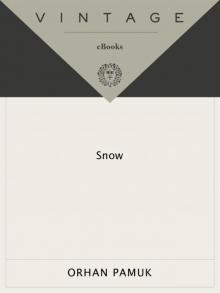 Snow
Snow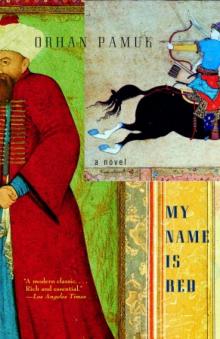 My Name is Red
My Name is Red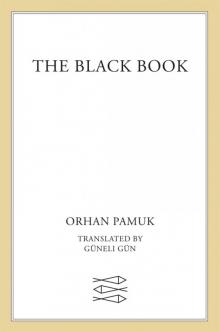 The Black Book
The Black Book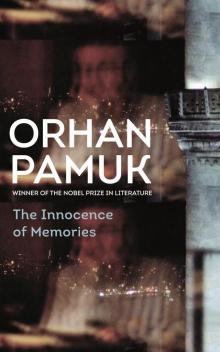 The Innocence of Memories
The Innocence of Memories The White Castle
The White Castle Other Colors
Other Colors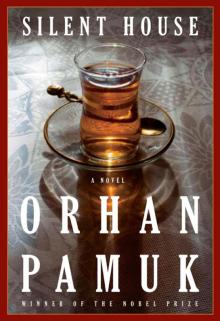 Silent House
Silent House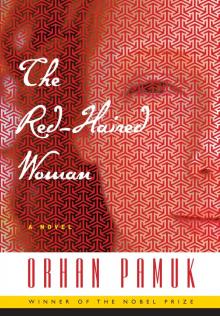 The Red-Haired Woman
The Red-Haired Woman The Museum of Innocence
The Museum of Innocence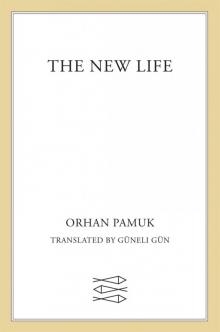 The New Life
The New Life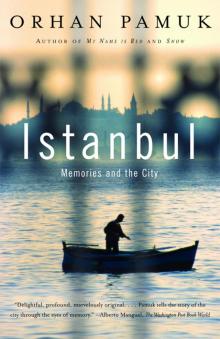 Istanbul
Istanbul